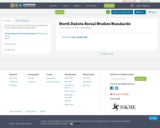
Social Studies Content and Achievement Standards for the state of North Dakota. Updated 2007.
- Subject:
- Arts and Humanities
- History
- Social Science
- Material Type:
- Primary Source
- Date Added:
- 03/21/2018

Social Studies Content and Achievement Standards for the state of North Dakota. Updated 2007.

Visual Arts Content and Achievement Standards for the state of North Dakota. Updated 2000.
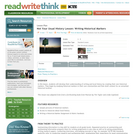
Students will develop their summarizing skills while learning about local history. They will learn to consider audience while selecting topics, conducting research and interviews, and writing historical markers for their town.

The MIT Nuclear Weapons Education Project aims to teach individuals, particularly those who grew up after the end of the Cold War, about what nuclear weapons are and their effects on the world. The project website provides materials for lectures or discussions at introductory course levels.

This course was designed to educate students about how nuclear weapons came into being, the physics of these weapons, how they are structured, how they have evolved over the past several decades, efforts to control them and limit the threats that they represent, and what the possibilities for the future are. Many people in our country and other countries are not aware of what an existential threat nuclear weapons represent, and this lack of awareness is an important part of the overall threat.
The course was taught by an MIT Iterdisciplinary team coordinated by Robert P. Redwine, Professor of Physics Emeritus. The full list of instructors is listed on the course page.
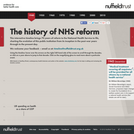
Our interactive timeline brings 70 years of reform to the National Health Service (NHS) to life, charting its evolution from inception through to the present day.
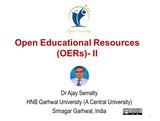
The Topic deals with the history, origin and timeline of OER globally.

Below is a presentation on the use of TimelineJS as an OER on multiple university platforms and how it's features can be adapted and utilized within high school classrooms.
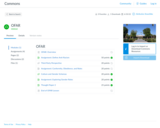
This chapter we will be acknowledging and bringing awareness to the historical discrimination that has barred education and research access to those in the Psychological field due to color, gender and other racial biases. Only by understanding this prejudice and racial discrimination can we discover the root causes of inequity and recognize those in the field that had a direct and positive contribution to the development of the field of Psychology.
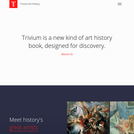
Obelisk (formerly Trivium) Art History is a free, online art history textbook designed for discovery. Meet history's greatest artists, browse artwork, and explore the timeline of human creativity. Trivium offers short, conversational essays and artist biographies and encourages exploration by artistic movements, mediums and themes.

Through this lesson, students in 3rd-5th grade will understand how the human history of a local creek (Whatcom Creek in this example) affects the health of salmon populations. This lesson is an active way to engage students in graphing through the use of models and uses critical thinking to understand implications of human actions in the past and in the future.

Class website: The Once & Future City
What is a city? What shapes it? How does its history influence future development? How do physical form and institutions vary from city to city and how are these differences significant? How are cities changing and what is their future? This course will explore these and other questions, with emphasis upon twentieth-century American cities. A major focus will be on the physical form of cities—from downtown and inner-city to suburb and edge city—and the processes that shape them.
These questions and more are explored through lectures, readings, workshops, field trips, and analysis of particular places, with the city itself as a primary text. In light of the 2016 centennial of MIT’s move from Boston to Cambridge, the 2015 iteration of the course focused on MIT’s original campus in Boston’s Back Bay, and the university’s current neighborhood in Cambridge. Short field assignments, culminating in a final project, will provide students opportunities to use, develop, and refine new skills in “reading” the city.

Open History is a free and open World History textbook designed for Adult Basic Education students to practice skills for High School Equivalency (HSE). It can be used as a reading for information text for RLA Reading and to practice important skills for Social Studies.
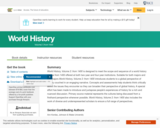
World History, Volume 2: from 1400 is designed to meet the scope and sequence of a world history course from 1400 offered at both two-year and four-year institutions. Suitable for both majors and non majors World History, Volume 2: from 1400 introduces students to a global perspective of history couched in an engaging narrative. Concepts and assessments help students think critically about the issues they encounter so they can broaden their perspective of global history. A special effort has been made to introduce and juxtapose people’s experiences of history for a rich and nuanced discussion. Primary source material represents the cultures being discussed from a firsthand perspective whenever possible. World History, Volume 2: from 1400 also includes the work of diverse and underrepresented scholars to ensure a full range of perspectives.
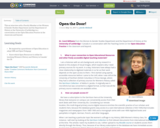
This an interview with a Faculty Member at the Women & Gender Studies Department and the Department of History at the University of Lethbridge in a conversation on her Open Education Practice in the classroom and beyond.

An illustrated sheet music cover for a song by George W. Babcock (Thomas Comer, composer) and dedicated to Samuel R. Spinney, Esq. The design shows Columbia or American Liberty (center) wearing a gorgon's head on her breast and a Phrygian cap ornamented with stars. She holds a shield and an American flag. On the ground to the right is an eagle with arrows and a streamer with the motto "E Pluribus Unum." On the left is a kneeling female figure, presumably representing Learning or History, holding a laurel wreath and a large book. She motions with her left hand and looks toward Columbia. Behind, in a bare mountainous landscape under a cloudy sky, sits a classical temple-like building with a dome supported by a large peristyle lantern.|A variant copy (cover only with different image) is in P&P LOT 10615-34; LC-USZ62-89295.|Boston. Published by Oliver Ditson & Co. 277 Washington St.|Entered . . . 1858 by O. Ditson & Co.|John H. Bufford's Lith.|The Library's copy of the sheet music was deposited for copyright on December 8, 1858.|Title appears as it is written on the item.|Published in: American political prints, 1766-1876 / Bernard F. Reilly. Boston : G.K. Hall, 1991, entry 1858-5.

From Pre Contact to Post Factual America
Short Description:
A US history ancillary/textbook that examines some traditional some non-traditional aspects of American social, cultural, gender, racial, political, and military history. Most chapters include content provided by community college students.
Long Description:
Historians talk about change over time, but change is not linear. Rather nebulous and with unforeseen consequences. The historian Dr. Nancy Hewitt talks about a complexity of change over time. While change can positively affect one group sometimes that same change negatively affects another group, she argues. Change is both progressive and regressive. Change is embraced and at the same time rejected. The events of January 6th, 2021 demonstrate that.
For example, The territory of Washington granted women the right to vote in 1883, then took away that right in 1887. Women regained the right to vote in 1888 by another act of the territorial legislature, but that bill was overturned by the Territorial Supreme Court the same year. Women in Washington then re-regained the right to vote with the adoption of the new state Constitution in 1910. The Prohibition Amendment was supposed to result in a cleaner, more sober society. What it brought, among other things, was the rise of organized crime. The Eighteenth Amendment was the only change to the Constitution that restricted rights. The idea that change necessarily advances society is inaccurate. In fact, continuity and change can happen simultaneously.
The world is too complex for a linear narrative. The trajectory of society on an evolutionary tract that is positive is not a normal phenomenon. Change does not always mean better. Likewise, continuity has both its detractors and proponents such as the vote in the US Senate for removing the 17th, 37th, 42nd and 45th (twice) president from office after the House of Representatives had found those men guilty of various high crimes and misdemeanors.
Impeachment is not normal. Republicans impeached Andrew Johnson (D) for a myriad of things to include “heaping ridicule upon Congress.” Richard Nixon (R) resigned when it became apparent that he did not have the number of votes in Congress to keep him in the Oval Office. Republicans impeached Bill Clinton (D) for lying about committing adultery. And now the Democrats, who control the House, impeached Donald Trump, twice, including “inciting violence against the government of the United States.” Impeachments are not normal times.
Not unlike Andrew Jackson, Donald Trump attracted exceptionally divergent positions. All presidents have their detractors. Some more than others. Rush Limbaugh seemingly made his career going against the Clinton administration (and women and POC). But the model of this book is not about presidential personalities but rather, for example, are the domestic and foreign policies of presidents more of a continuity of policy, or, are some more in line with Gilded Age policies as some historians have pondered? A change from the path the US has been on since the Progressive era? And, how did those changes and continuities affect various groups of Americans?
The idea of “All men are created equal” didn’t mean “all men” in 1776 but by 1877 “all men” certainly included most American men, at least on paper. Women were granted the right to vote, then Native Americans, then the 1964 Civil rights Act, then the Americans with Disabilities Act. Our liberties seemingly expand over time. But then the Supreme has been chipping away at the 1965 Voting Rights Act since 2013. Then the Dobbs decision (2022) took away a women’s right to control her own body. A right she had since Roe (1973). So in some cases, liberties might be contracting.
Was the exclusion of Chinese or the forced Americanization of Native American children in the 19th century similar or not to policies that restrict Muslim immigration or remove immigrant children from their parents in the 21st century? Or, politicians who lament that certain ethnic groups do not assimilate as quickly or thoroughly as other groups in both the Gilded Age and more recently?
Are the speeches, policies, and practices normal throughout US history over the long run, or has US history altered its path since September 11th? Finally, what does that change or continuity mean? Vamos a ver.
In part, this book is not normal because the focus whenever possible is not on the elite, the Great Men, but on us -what that active duty Air Force staff sergeant and his pregnant wife from Wisconsin, both civil rights marchers, witnessed what was going on at the Mall in DC on August 28th, 1963, as opposed to focusing on the speeches of King, John Lewis and Rabbi Joachim Prinz. This book will focus on the thoughts of a then-seven-year-old watching TV, as his mom hurriedly made his lunch because as he overslept that morning, on September 11th 2001 as opposed to mentioning the goat book and that 11-word message whispered to President Bush by his Chief of Staff.
When possible, we use the diaries and letters of our relatives, co-workers, and friends. Gleaned from out-of-print newspapers, uncovered at local historical associations, and extracted from oral histories, some done by my students, we uncover the words, deeds, and experiences of average people. Sometimes my students are the subjects of those oral histories. Some of the narrative contained within this book is the work of my undergrads at Houston Community College. My student contributors are listed at the end of each chapter. This OER is a true collaboration. History through our experiences. This is Our Story.
Word Count: 324461
(Note: This resource's metadata has been created automatically by reformatting and/or combining the information that the author initially provided as part of a bulk import process.)
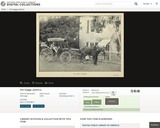
This photo of a buggy, a rider and a man leading the horse was taken in Jamaica in 1900.
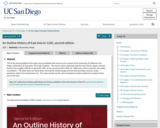
This is the second edition of the open access textbook that arose out of a course at the University of California, San Diego, called HILD 10: East Asia: The Great Tradition. The course covers what have become two Chinas, Japan, and two Koreas from roughly 1200 BC to about AD 1200. As we say every Fall in HILD 10: “2400 years, three countries, ten weeks, no problem.” The book does not stand alone: the teacher should assign primary and secondary sources, study questions, dates to be memorized, etc. The maps mostly use the same template to enable students to compare them one to the next.
The 1st edition is in the supplemental material tab.

(See description)